Reserve Bank of Australia Annual Report – 1996 The Economy and Monetary Policy
The economy began 1995/96 showing divergent influences. Growth in activity had eased from the unsustainably strong pace of 1994, leaving some uncertainty about the extent of the slowing. At the same time, accelerating wage demands, fuelled by the surge of growth in 1994, were beginning to feed through to inflation. The threat to price stability was exacerbated by the sharp fall in the exchange rate in the first half of 1995.

These divergent forces were largely resolved during the year, paving the way for interest rates to be eased in July 1996. The expansion in economic activity continued at a moderate pace, with employment growth just matching the growth in the labour force, so that unemployment remained virtually unchanged over the year. The slower expansion took some of the heat out of wage pressures, and by the end of the year average wages were running at a pace broadly consistent with the 2–3 per cent inflation objective. Inflation – as usual, a lagging reflection of unfolding events in the economy – was gradually contained, peaking at 3.3 per cent in underlying terms in the March quarter, before falling to 3.1 per cent. These developments were shaped by the monetary policy adjustment which occurred in the second half of 1994. With inflation set to fall further in 1996/97 to within the 2–3 per cent range, the way was open to ease monetary policy in July 1996.

Australia has now achieved five years of economic expansion, the last four at an average rate of almost 4 per cent, combined with average inflation of about 2¼ per cent. This performance rates well both by historical and international standards. Getting inflation down from the unacceptably high rate of the 1980s was painful, but the past five years show that maintenance of low inflation has not been at the expense of growth in economic activity. Unemployment in Australia remains high but has headed lower, to be in the middle rank of industrial countries. If wage restraint can be sustained, the economy is poised to advance at a pace which will gradually reduce unemployment, and further consolidate Australia's position as a low-inflation country. The easing of monetary policy in July 1996 is consistent with both objectives.
Major economic indicators: selected countries
(Average annual growth – 1992 to 1995)
| GDP | Core CPI | Unemployment rate* | |
|---|---|---|---|
| United States | 2¾ | 3¼ | 5½ |
| Japan | ½ | 1 | 3½ |
| Germany | 1½ | 3½ | 10¼ |
| France | 1¼ | 2 | 12½ |
| United Kingdom | 2 | 3¼ | 7¾ |
| Italy | 1 | 4¾ | 12¼ |
| Canada | 2¼ | 2 | 9½ |
| Belgium | 1¼ | 1¾ | 14 |
| Netherlands | 1¾ | 3 | 6½ |
| Sweden | ½ | 3 | 7¾ |
| Switzerland | ¼ | 2¾ | 4½ |
| Spain | 1¼ | 5½ | 22½ |
| New Zealand | 3¾ | 1½ | 6¼ |
| Australia** | 4 | 2¼ | 8½ |
| OECD | 1¾ | 3¼ | 7½ |
| * June quarter 1996 average ** For Australia, GDP and core CPI refer to 1992/93 to 1995/96 |
|||
As always, different structural and cyclical factors influenced the course of the economy over the past year, but three stand out:
- the international environment;
- the cyclical response to the 1994 monetary policy tightening; and
- the continuing adaptation of the economy to low inflation.
The international environment
The international economy, and particularly developments in the US, has a powerful influence on economic activity in Australia. Trade is part of the story, but the channels are broader than this, with the US having an influence disproportionate to its modest share in our overseas trade. The strong linkage with the US also reflects a number of other factors, such as the influence of trends in US financial markets on those in Australia, the importance of the US economy in driving commodity prices, and the positive effect on confidence in Australia of healthy growth in the US.

The international background was fairly benign for the Australian economy in 1995/96, with growth in the OECD area of about 2 per cent, but non-Japan Asia growing a good deal faster. The experience of the “Big Three” economies was mixed: the US was close to full employment; Japan began to recover; and Germany was in recession until late in the year. Inflation remained low in industrial countries, giving many countries room to ease monetary policy over the second half of 1995 and into 1996, as economic growth weakened in a number of them. With no major disruptions of the kind evident in the previous year, market developments were supportive of growth; importantly, exchange rates remained around levels consistent with underlying economic conditions.

As in Australia, the US economy had grown at an unsustainably fast pace in 1994, and policy was adjusted to slow it down – to aim for a “smooth landing” in popular parlance. The slowdown was achieved and this eased inflationary pressures, giving room for modest cuts in official interest rates over the second half of 1995 and early in 1996. The policy easings, and growing confidence that inflationary pressures had been contained, established the foundations for faster growth in 1996.
Japan's prolonged period of weakness continued until late in 1995, when tentative signs of recovery emerged. The sluggishness in Japan reflected the weakness of its banking system, following the collapse of the “Bubble Economy” of the late 1980s. It was compounded by the sharp appreciation of the yen early in 1995, falling share prices and the failure of several financial institutions. The official response was to ease monetary policy progressively, with official interest rates cut to an historical low; adopt a highly expansionary fiscal policy stance; and take steps to resolve the banking crisis. As a result, market trends became more supportive: the yen depreciated, bond yields fell and share prices recovered, boosting both profitability and business confidence. Responding to these developments, economic activity began to show signs of strength, and by mid 1996, the upturn in Japan looked to be well established, with inflationary pressures virtually non-existent.
Germany, on the other hand, slowed sharply towards the end of 1995, exerting a contractionary force over the whole of continental Europe. A major catalyst in this slowing was the loss of competitiveness from the appreciating Deutsche mark and large wage increases of early 1995. Those problems were aggravated, however, by ongoing structural problems in European economies and rigid labour markets. Large and entrenched budget deficits and high levels of public sector debt limited the capacity of fiscal authorities to respond to the downturn. The approach of the deadline for complying with the Maastricht criteria on fiscal policy, which will require significant fiscal contraction across Europe, also undercut business confidence. The consequences are reflected in high unemployment rates, which rose further in several countries as economic activity slowed. With economic activity sluggish and inflation falling, monetary policy was eased in many European countries, including in Germany, over the year, helping pave the way for a return to growth. Although activity had picked up by the June quarter, the outlook for Europe looks more subdued than for the United States or Japan.




The continuing growth in non-Japan Asia provided new trade opportunities for Australia. While growth remained strong for the region as a whole, some countries showed signs of slowing. In a few cases, emerging inflation and rising current account deficits prompted monetary policy tightenings. Rapid economic growth continued in China, along with the lower rate of inflation achieved in the previous year. A pronounced slowing was evident in Taiwan, as military tensions with China saw business confidence wane, and in Hong Kong, on the back of deteriorating consumer confidence and falling property prices. The picture was healthier in South Korea and Singapore; in both countries growth remained strong and inflationary pressures moderated. The long period of fast growth in Indonesia, Malaysia and Thailand has produced a number of pressures, including higher inflation and larger current account deficits, which has prompted some monetary policy tightenings.
After a lacklustre performance in the first half of 1995, commodity prices began to rise about the middle of 1995 as the outlook for the world economy became brighter, and this buoyed the $A exchange rate. The rise also improved the prospects for Australian resource companies, boosted their share prices and encouraged strong flows of equity capital. These capital flows were reinforced by favourable interest relativities, especially against Japan. The renewed strength of the exchange rate during 1995/96 was a major influence on the improved outlook for inflation in Australia.
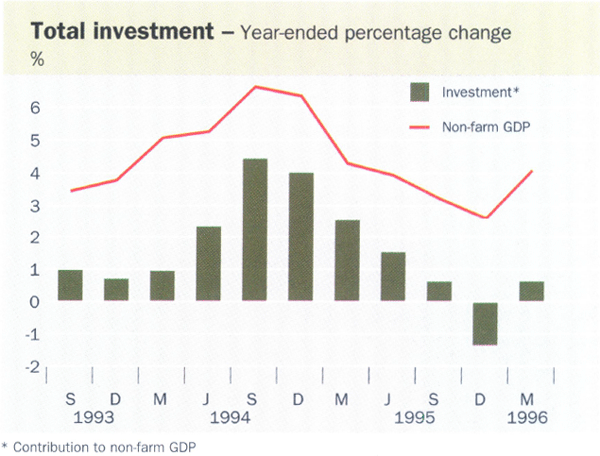
Cyclical influences
The cyclical influences on the economy during the past year stemmed, in large part, from the tighter monetary policy of late 1994. Higher interest rates operated through profit prospects, cash flows and general confidence to influence the most cyclically volatile component of expenditure, namely investment – business investment; dwellings; and inventories. Movements in these areas can explain most of the variation in aggregate expenditure over the course of the current cycle.
By early 1995, business sentiment had become more subdued, reflecting uncertainty about whether the economic recovery would be sustained and whether interest rates would be raised further, but also disappointment at lower-than-expected levels of corporate profits. Investment in plant and equipment weakened in the second half of 1995, but picked up again as sentiment steadied and international prospects improved in early 1996.
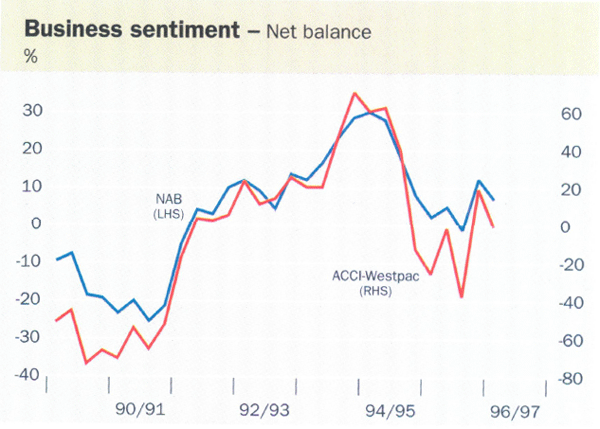
The weakness in equipment investment was offset by a revival in construction investment, which finally shrugged free of the depressing effects of the overhang in commercial property. Its strength was most evident in the engineering sector, reflecting high levels of investment in resource-related industries and a number of major private-sector infrastructure projects. In aggregate, business investment looks to have increased by over 10 per cent in 1995/96.
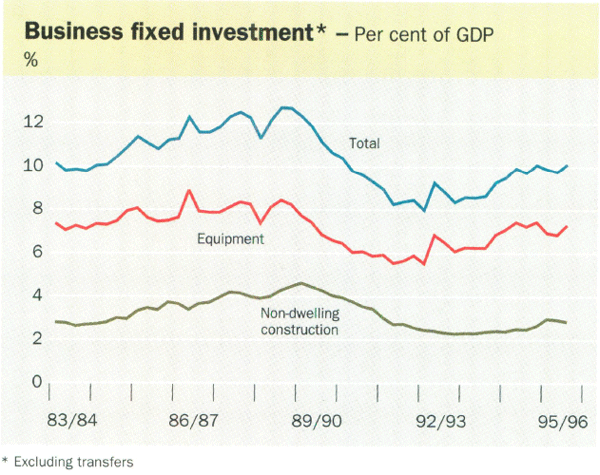
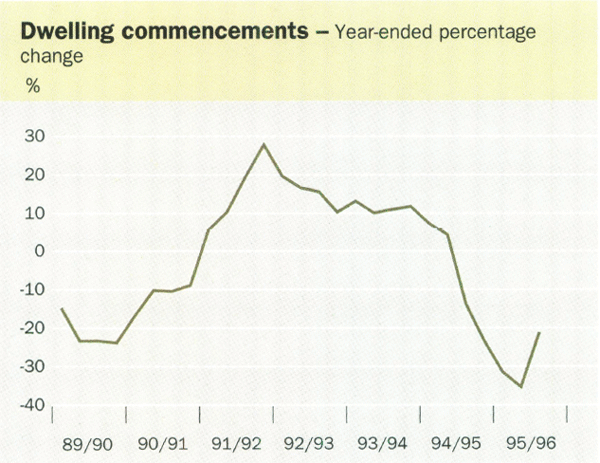
As the economy slowed in 1995, businesses experienced the usual difficulty in adjusting production to slowing demand, and inventories built up. This was particularly the case in manufacturing, where output had grown exceptionally quickly in 1994 but, as demand fell away, had to shoulder the bulk of the economy's inventory adjustment.
The other element of investment with a pronounced cyclical pattern is housing. The housing cycle had run ahead of the overall economic expansion, resulting in significant overbuilding. The surplus housing had to be sold and, in the meantime, new construction was curtailed sharply. The 1994 tightening of monetary policy, although significant, was not the major factor behind the downswing; by historical standards, mortgage interest rates remained low and housing credit, although slowing, remained adequate to support reasonable growth in housing activity. Of more importance was the imbalance which occurs when housebuilding outstrips the underlying growth in demand set by demographics. By early 1996, these imbalances were being corrected, by contracting new construction; housing starts were running at an annual rate of 125,000 a year, down by about a third from their peak in mid 1994, and below the rate required to keep up with underlying demand. As a result, the stock of newly erected vacant dwellings began to fall, setting the scene for a recovery in housing activity. Recent indicators suggest that housing activity has steadied, with some pick-up expected in the second half of 1996.
The structural adaptation to low inflation
An important ongoing influence on the economy has been its gradual adaptation to low inflation. Although inflation has been low for the past five years, the psychology of price stability is not yet firmly entrenched, and many parts of the economy are still in the process of adjusting to the new environment. Delays in making this adjustment can cause problems of the kind which appear to have affected parts of the manufacturing sector.
Manufacturing output has grown by more than 20 per cent over the past five years, about the same as it did during all of the preceding economic cycle. This advance has been built on exports which, since 1986, have risen at an average of 18 per cent a year. Tariff cuts and micro-economic and labour market reforms have enhanced international competitiveness, and Australian manufacturers have seized opportunities in Asia's rapidly growing economies.
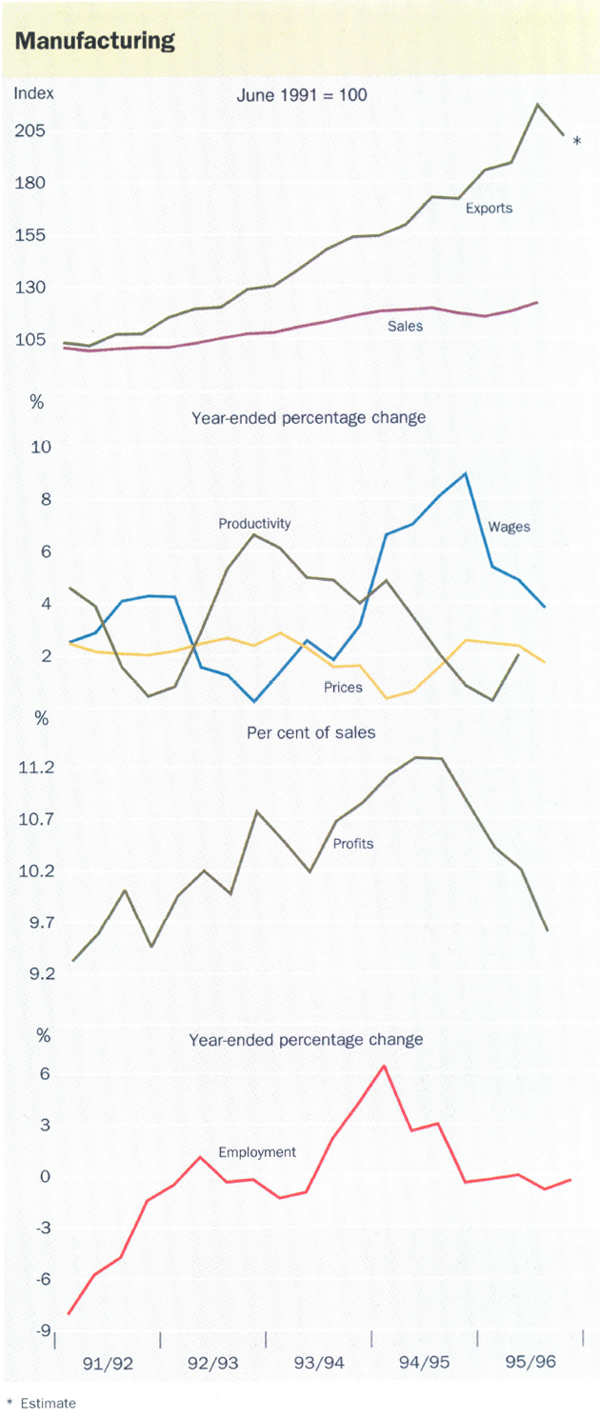
These favourable longer-term trends, together with good productivity performance, encouraged generous wage increases in 1994, at the same time as the discipline of the international marketplace was reducing manufacturers' scope to raise selling prices. Pricing power was also reduced by the slowing of the economy in 1995. With wages in manufacturing rising strongly, but prices rising by under 2 per cent, and a cyclical slowing in productivity, profits in manufacturing fell in 1995/96, as did employment. With a “cost-plus” approach to pricing no longer feasible in the face of sharper competition, some enterprises trimmed their workforces to restore margins.
In the period of high inflation of the 1970s and 1980s, businesses also had become accustomed to substantial nominal profit increases. This expectation was not disturbed in the early stages of the cyclical expansion, when the faster tempo of economic activity always boosts profits. As the cycle matures, however, continuing increases in the profit share are much harder to deliver, as factor shares of national income tend to stabilise. The gradual realisation that profit growth would be modest dampened business sentiment, which was reflected in weak business investment in the first half of 1995/96.
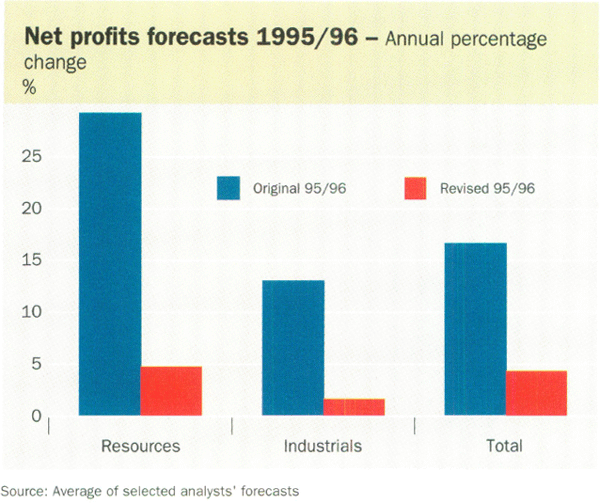
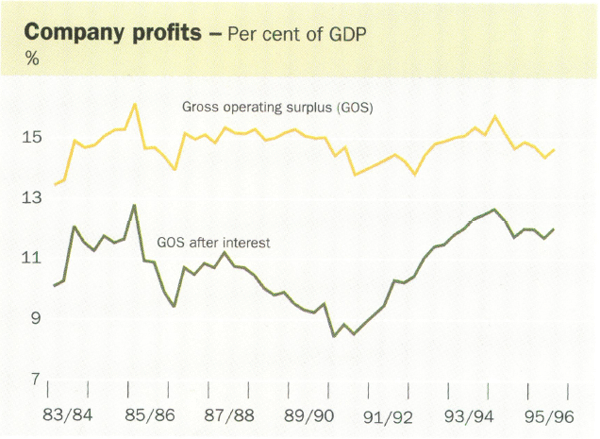
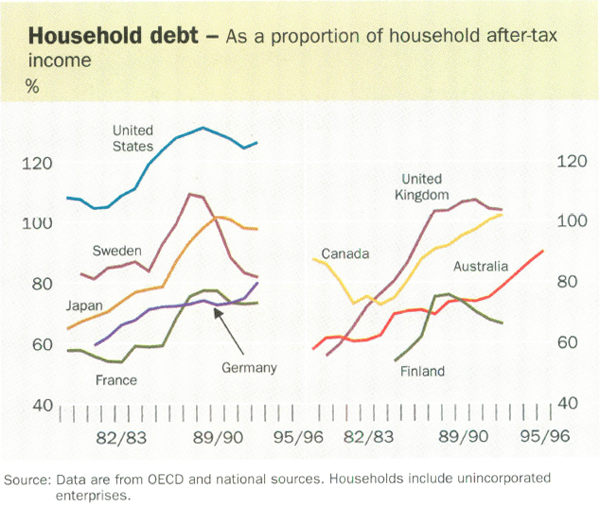
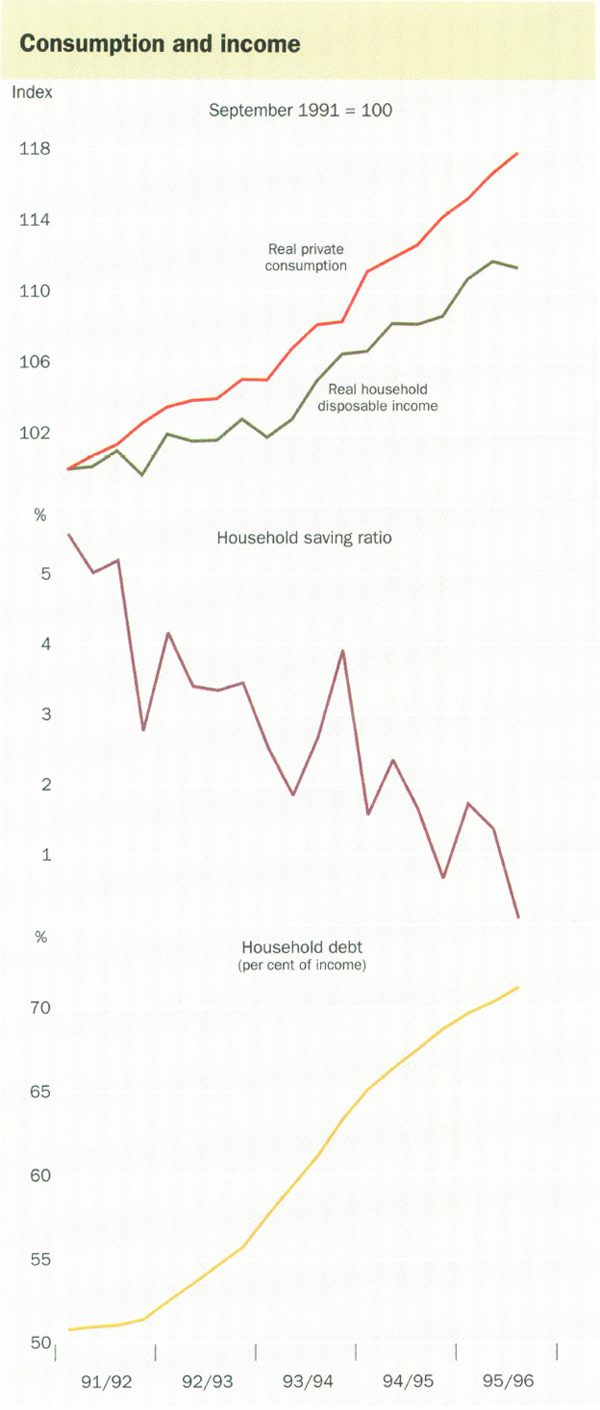
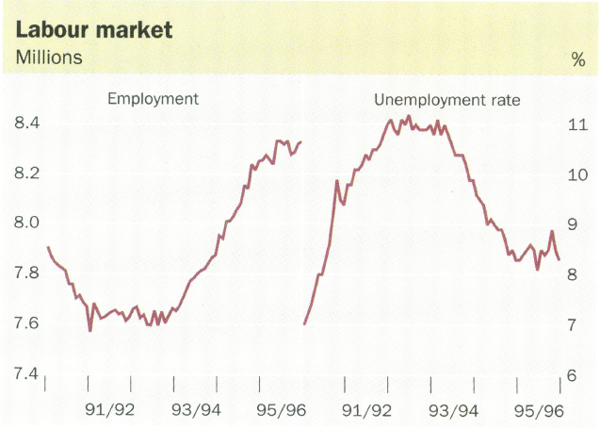
The slow adaptation to a low-inflation world was not confined to manufacturing. Unrealistic expectations of profit increases were widely held and are only now being wound back. One benefit from low inflation, however, is that the accompanying lower structure of nominal interest rates continued to boost post-interest profits and cash flow, even though aggregate profits had declined from their peak in September 1994. Interest payments are currently equivalent to 18 per cent of company gross profits, compared with about 40 per cent in 1990.
In other aspects of business, the structural adaptation to low inflation seems to have been achieved. Balance sheet adjustment following the overborrowing of the late 1980s, for example, seems to be complete.
While the adjustment to low inflation has seen businesses reduce their gearing, households continued to increase leverage during 1995/96. This was one of the factors behind the continuing fast growth of consumer spending. At 4 per cent, it grew faster than household disposable income, causing household saving to fall further. Continuing robust growth in household credit, and the associated upward trend in household indebtedness, mainly reflects the combination of historically low nominal interest rates and heightened access to credit resulting from financial deregulation. Similar trends were evident in the 1980s in a number of other countries – such as the United States, the United Kingdom and Canada – in the wake of their financial liberalisation and return to low inflation.
Increased household gearing does not seem to have placed a strain on household balance sheets and their capacity to service debt remains comfortable. Debt-servicing payments are still well below their peak of the late 1980s and household indebtedness in Australia remains moderate by international standards. Although trends in household spending and indebtedness are not a cause for alarm, a greater propensity to save among households would clearly be desirable from the perspective of raising national saving.
Labour market
Employment growth was broadly in line with the path of economic activity, but the within-year movements were quite variable, and their interpretation was complicated by uncertainties relating to the data. Over the year, employment rose by 1.0 per cent, compared with 4¾ per cent during the previous year. The slowing was evident among both part-time and full-time workers, but was more pronounced among full-time workers. Despite the slower growth in 1995/96, employment has increased by around 10 per cent, or over 750,000, since the trough of the recession in mid 1991.
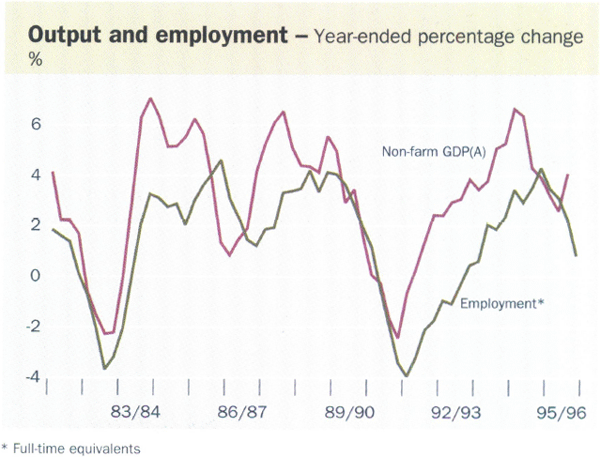
Over the past eighteen months the slowing in employment has been more pronounced than the slowing in economic growth. Part of the explanation for this might be found in the disparate developments in different sectors of the economy, with employment falling in those sectors bearing the brunt of cyclical forces – manufacturing and construction – and in parts of the public sector. The weakening in employment growth around the turn of the year was, however, apparent even in those sectors (such as services) where demand was robust, which suggests that a wage/price squeeze was constraining profits and recruitment.
Movements in real wages also seem to have aggravated the slowing in employment in the past year. A prominent feature of the labour market in Australia in recent decades has been the sensitivity of employment to movements in real wages that have run ahead of gains in labour productivity. This effect was most evident in the mid 1970s and early 1980s when real wages moved out of line with productivity, exacerbating the effect of slowing demand on employment in those periods. This imbalance was redressed in the 1980s, assisted by the Accord, and a period of sustained growth in employment ensued, a period halted by the recession of the early 1990s. In the early stages of the subsequent upswing, real labour costs remained well contained, but began to increase noticeably in 1994, with an adverse effect on employment growth.
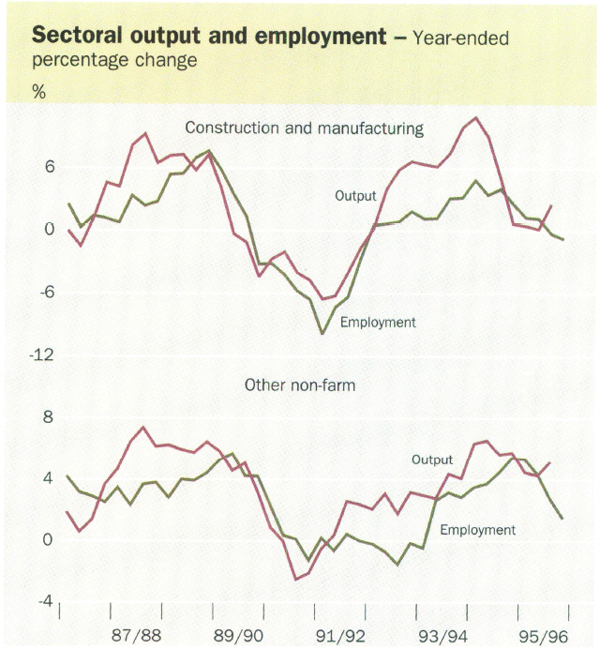
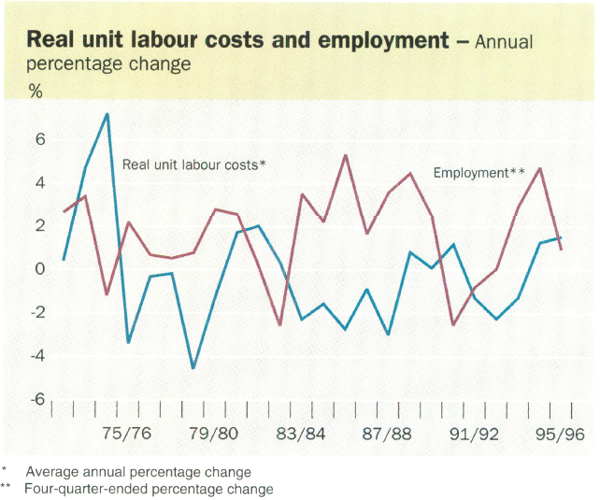
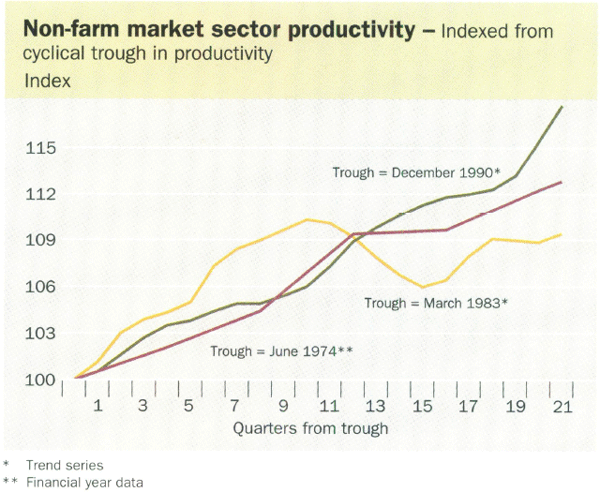
Real wages should rise over time in line with the growth in labour productivity. Recent trends in labour productivity, if they were to persist, would offer the prospect of significant rises in real wages and higher standards of living. Trend growth in economy-wide labour productivity picked up appreciably in the 1990s, to average around 1¾ per cent a year, compared with an average of about ¾ per cent a year through the upswing of the 1980s. The improvement in private-sector productivity is still more pronounced. Recent productivity gains reflect the fruits of widespread micro-economic reform over the past decade, including tariff cuts and a generally more competitive environment. In the long term, such policies raise incomes, improve prospects for employment and provide higher standards of living but, in the short term, they can involve adjustment costs, including to lower levels in employment.
The unemployment rate was largely unchanged over the year, at around 8½ per cent. Long-term unemployment continued to fall in 1995/96, with the unemployment rate of those out of work for more than a year falling to 2¼ per cent of the total labour force; this is still higher than for much of the 1980s, but well down on the peak of above 4 per cent recorded in mid 1993. The concentration of unemployment among certain groups in the community suggests that, while lasting reductions in unemployment require sustained growth in economic activity combined with restraint in labour costs, there is also a role for training and other programs targeted at groups figuring prominently among the unemployed.
Balance of payments
The current account deficit declined from $27.6 billion (6 per cent of GDP) in 1994/95 to $20.5 billion (4¼ per cent) in 1995/96, with an improvement in the balance on goods and services partially offset by a further widening of the deficit in net income.
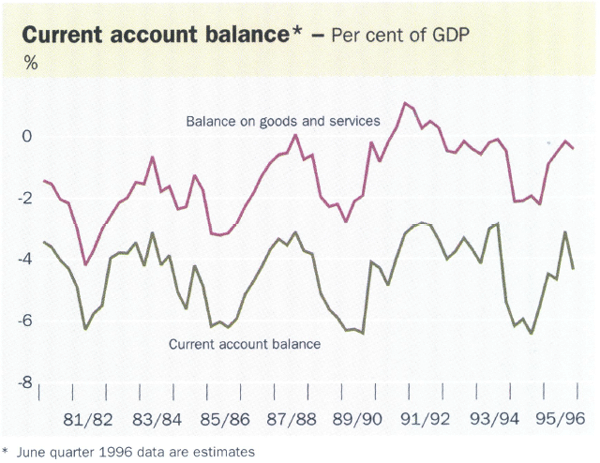
The quantity of exports of goods and services rose by around 10 per cent in 1995/96, partly reflecting the rebound in rural exports from the drought-affected levels of the previous year; in particular, exports of wheat rose by half to 12½ million tonnes. The favourable longer-term trends evident for some time in the structure of Australia's exports continued, with exports of manufactured goods rising by about 20 per cent in the year, along with another solid rise in exports of services which resulted in trade in services being in virtual balance in 1995/96. Exports of manufactures and services have contributed disproportionately to growth in exports for a number of years, with their shares in total exports showing a marked rise over the past decade.
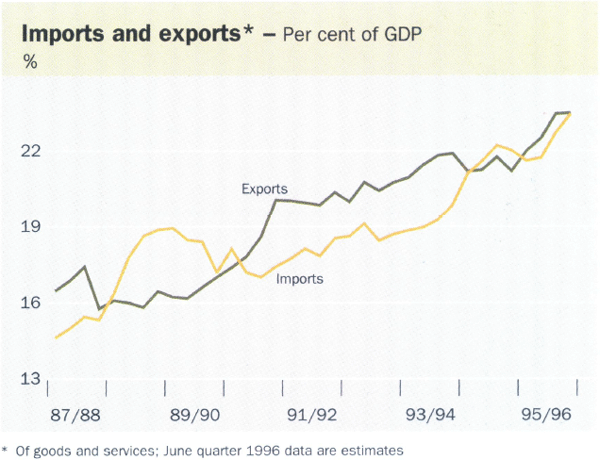
|
Composition of exports (%) |
Contribution to increase over the past decade* |
||
|---|---|---|---|
| 1985/86 | 1995/96 | ||
| Resource-based | 42 | 36 | 33 |
| Rural | 31 | 22 | 15 |
| Manufactures | 9 | 19 | 25 |
| Services | 18 | 23 | 27 |
| Total | 100 | 100 | 100 |
| + Current prices * Percentage contribution to rise in exports |
|||
As a result of these trends, external markets have been rising in importance for Australian manufacturers; the share of exports in manufacturers' sales has more than trebled in the past decade, to almost 20 per cent. Service exports have grown at an average of about 10 per cent a year over the past decade. This has been concentrated in tourism, but with significant contributions being made by education and business-related services. Given Australia's natural endowments, resource-based exports remain the largest single source of export revenue. Given the projected strong growth in mining investment, and some pick-up in the world economy, prospects for mineral exports look favourable.
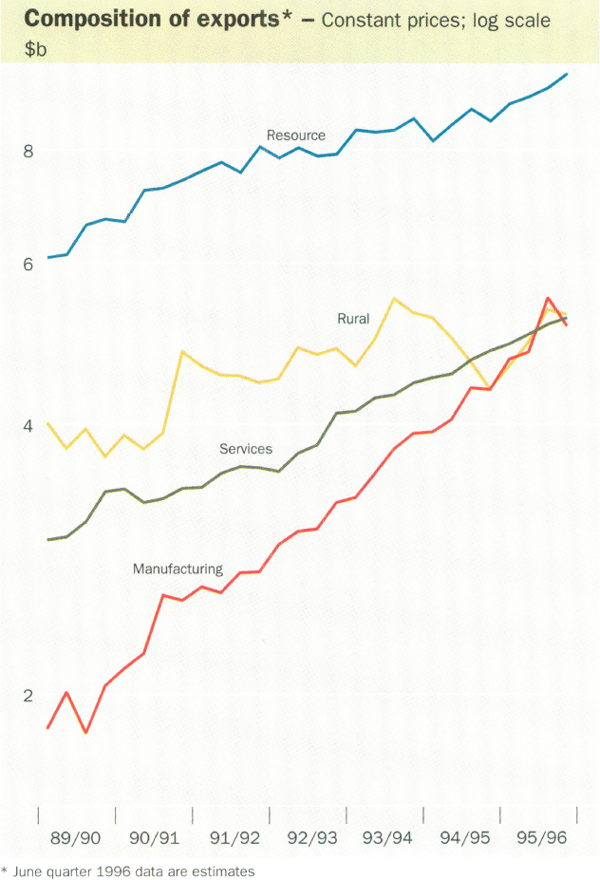
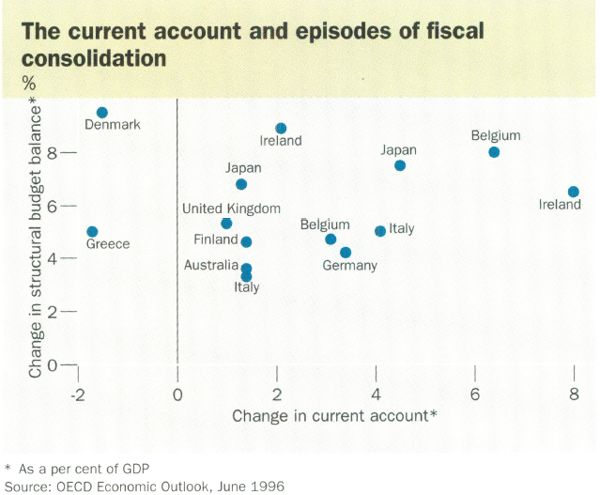
Rising commodity prices have also assisted exports over the past year. Wheat prices in particular rose strongly for a time, bolstered by low world stocks, and coal and iron ore prices also made significant gains. The terms of trade rose by 3½ per cent over the year to the March quarter, continuing the rising trend of the previous two years, when they moved up by about 6 per cent. The diversification of Australia's exports into manufactures and services should gradually reduce the volatility of Australia's terms of trade.
The swing in investment spending dominated movements in imports in 1995/96, with growth initially slowing in response to the fall in investment early in the year but later recovering, spurred by the rebound in capital spending; in the year as a whole, imports of goods and services rose by 6 per cent. Imports of consumer goods were flat for much of the year, notwithstanding solid growth in domestic consumption and the rising exchange rate.
Australia's net foreign liabilities rose further in 1995/96. The trend toward increased foreign equity investment in Australia, which rose by $20 billion in the nine months to March, continued. Almost half of this rise reflected new acquisitions of equity by foreigners in Australian companies, and about a third reflected the valuation effect of rises in share prices in Australia. Net equity liabilities moved up over the nine months to March, from 16.9 per cent of GDP to 19.0 per cent. Over the same period, new foreign borrowings rose by $7 billion. Relative to GDP, net foreign debt stood at 38.8 per cent at end March, down from 39.6 per cent in June 1995. The aggregate servicing ratio of Australia's net external liabilities fell in 1995/96; total servicing costs fell from 22 per cent of exports of goods and services in the March quarter 1995 to 17 per cent in the March quarter 1996.
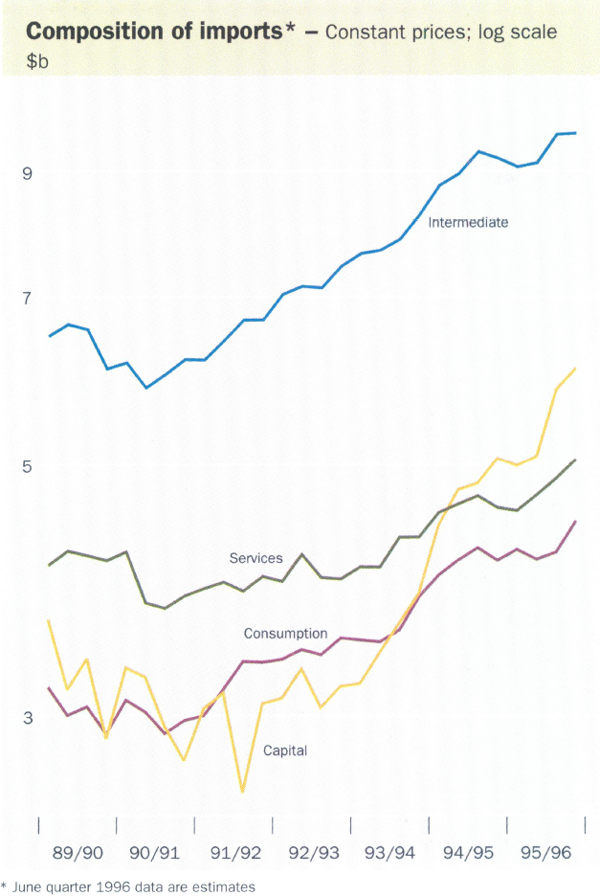
The ongoing large current account deficit and rising external liabilities are the results of Australia's poor national savings record. The declining level of national saving since the mid 1970s mainly reflects lower public-sector saving: gross saving by the public sector averaged almost 8 per cent of GDP in the 1960s and early 1970s, but has averaged a little over 2 per cent so far in the 1990s, largely because of lower saving by the Commonwealth Government. The most effective way of raising national saving, within a realistic timeframe, is to move the budget into surplus. International experience shows that structural cuts in budget deficits consistently have a favourable effect on the current account position, even if the timing is difficult to predict. Consequently, these effects can only be judged sensibly within a medium-term framework.
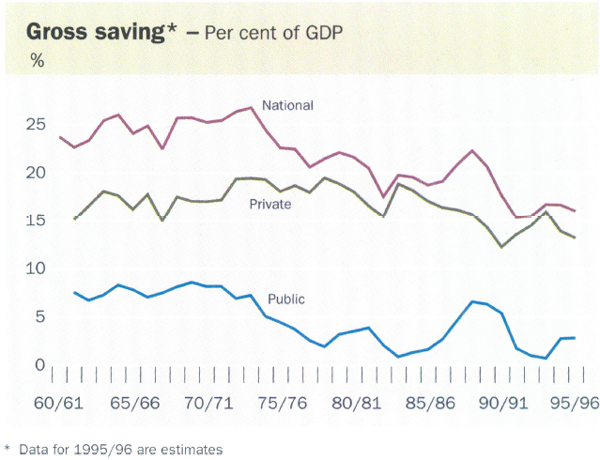
Public sector finance
The Government's announced plans to balance the underlying budget, if realised, would make a useful contribution to raising national savings. The Commonwealth's fiscal position remains in deficit, despite five years of sustained growth, and less progress was made on reducing the deficit in 1995/96 than was forecast at the time of the Budget – preliminary estimates put the deficit at $5.0 billion, compared with the surplus of $0.7 billion projected at budget time. The underlying budget balance, defined as the headline budget balance less net advances (which consist primarily of asset sales and net debt repayments from the States), is estimated to be a deficit of $10.3 billion (about 2 per cent of GDP). The slippage in the budget mainly reflected less buoyant conditions in the labour market, and lower inflation, than in the projections underlying the initial budget figuring. With State and local governments in underlying surplus by about a quarter of a per cent of GDP, the underlying public sector borrowing requirement is estimated to have amounted to 1¾ per cent of GDP in 1995/96.
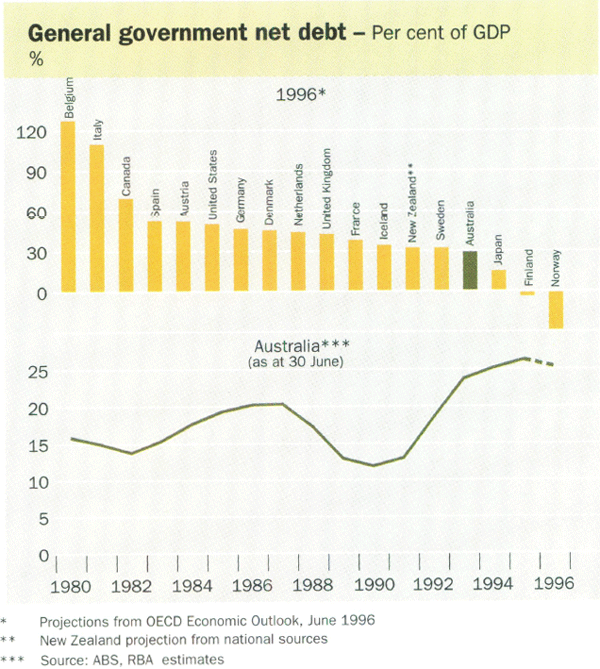
Public sector borrowings*
($ billion)
| 1993/94 | 1994/95 | 1995/96 (e) | ||||
|---|---|---|---|---|---|---|
| Commonwealth general government | 17.1 | 13.2 | 10.0 | |||
| % of GDP | 4.0 | 2.9 | 2.1 | |||
| memo item: | ||||||
| Total Commonwealth Budget | 17.1 | 13.2 | 10.3 | |||
| % of GDP | 4.0 | 2.9 | 2.1 | |||
| State and local general government | 0.6 | −0.4 | −1.6 | |||
| % of GDP | 0.1 | −0.1 | −0.3 | |||
| Public trading enterprises | −4.4 | −4.0 | −0.4 | |||
| % of GDP | −1.0 | −0.9 | −0.1 | |||
| Public sector borrowing requirement | 13.1 | 8.6 | 8.0 | |||
| % of GDP | 3.1 | 1.9 | 1.7 | |||
| * The definition used in this table shows budget deficits of these sectors, as measured by the Commonwealth Treasury, adjusted for net advances (which consist primarily of asset sales and net debt repayments from the States). Data for 1993/94 and 1994/95 are based on unpublished ABS data; data for 1995/96 are estimated on the basis of both published ABS data and estimates of the Reserve Bank. | ||||||
Pressures to consolidate budget positions are almost universal among industrial countries. In Europe, this pressure comes from the Maastricht Treaty, which requires that countries aiming to participate in the European Monetary Union reduce their deficits to less than 3 per cent of GDP, and their government debt to less than 60 per cent of GDP, by 1997. (Only one member of the European Union currently meets these requirements.) Japan proposes to withdraw the current degree of fiscal stimulus as the recovery progresses. In the United States, there is bipartisan agreement that the budget should be moved into balance over coming years.
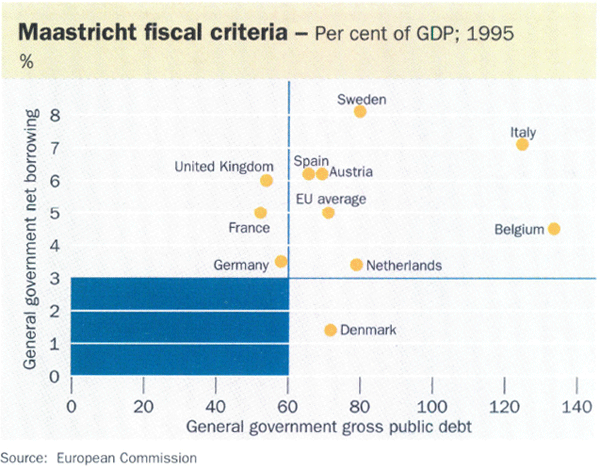
The widespread need for fiscal consolidation has given rise to concern that fiscal policy will unduly restrict economic activity. This is most clearly reflected in the gloom overhanging the European economies. Evidence about the effects of fiscal restraint, however, is ambiguous. It suggests that the fiscal position from which the process begins is important, with determined and credible efforts to rein in unsustainable fiscal positions often rewarded by rising confidence, giving favourable effects on economic activity even in the short term. The decline in the US budget deficit from 4¾ per cent of GDP to 2¼ per cent over the past three years, for example, has not derailed output or employment growth. This experience has parallels in other countries, including Australia's own experience in the late 1980s. More generally, the long-term effects of fiscal consolidation are clearly positive, with higher saving tending to promote economic growth by raising investment and lowering long-term real interest rates.
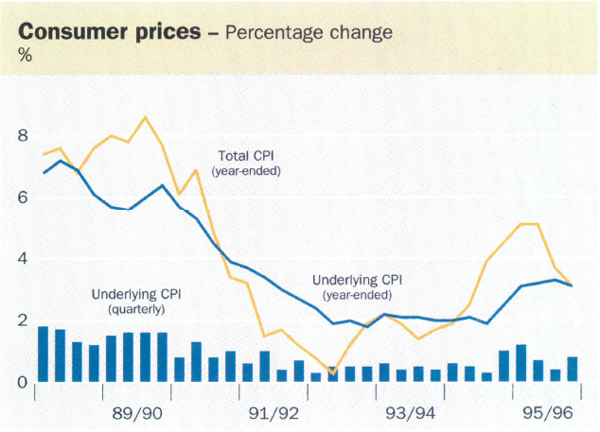
Inflation
Recent experience has demonstrated the benefits of expressing Australia's inflation objective in terms of an average of 2–3 per cent for underlying inflation over a run of years.
By mid 1995, underlying inflation had been running at an average of 2.2 per cent per annum for nearly four years, but stronger inflationary pressures were beginning to show. The June quarter CPI recorded an underlying increase of 1 per cent, followed by a rise of 1.2 per cent in the September quarter. These two quarterly figures were boosted by indirect tax rises (which added about a half of a percentage point to the increase over the two quarters, taken together). Even allowing for this, inflationary pressures were beginning to build. Wage growth was accelerating and the potential damage to inflationary expectations was exacerbated by the sharp rise in headline inflation, boosted by the policy-induced increases in interest rates in the second half of 1994. This gave rise to a risk that the 5-per-cent-plus being recorded in the headline figure would become the community's perception of the inflation “norm”.
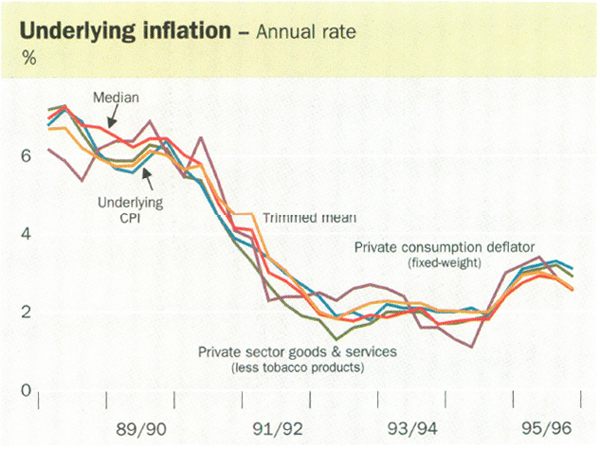
Inflation tends to lag other events in the cycle, and this slippage had been anticipated; it had, in fact, been the main motivation for the tightening of monetary policy in the second half of 1994. Nevertheless, with the exchange rate in mid 1995 about 10 per cent below the average level for 1994, the potential existed for significant slippage on inflation. The issue at stake was whether price expectations would shift adversely, setting back efforts to establish 2–3 per cent inflation as the focus for the community's wage and price-setting decisions.
In setting the 2–3 per cent objective, it was recognised that underlying inflation would, at times, move outside this narrow range in response to normal cyclical variations. This is why the objective had been specified in terms of an average over the cycle. While the Bank views the inflation objective as a central tendency, rather than a narrow path, the extent of variation around the central tendency matters. It was therefore important, in the first test of the objective, that inflation did not go too far above 3 per cent – nor stay above 3 per cent for too long. Until a good track record has been established, inflationary expectations will be vulnerable to upward revision. The Bank foreshadowed publicly that inflation was expected to rise above 3 per cent and explained that policy had been adjusted in anticipation of that prospect. In the event, the movement above 3 per cent was relatively minor and likely to be shortlived, and inflation expectations were not damaged.
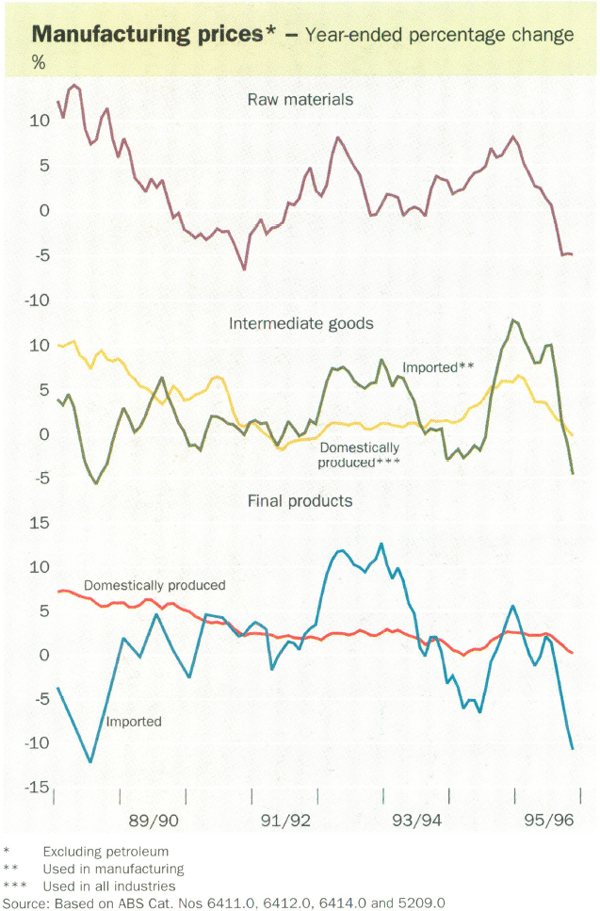
One element of the threat to price stability resolved itself quite quickly. As the exchange rate rebounded from its mid-1995 low, it switched from being a threat to price stability to a force for pushing inflation back under 3 per cent over time. The impact of the exchange rate shows up clearly in producer prices, not only in the prices of imported manufacturing goods but also in prices of domestic producer goods, which are influenced by the fall in import prices.
A more fundamental threat to inflation came from labour costs. Employment continued to grow strongly until April 1995 and, lagging a little behind this, wage costs accelerated to a rate of over 5 per cent in the year to the September quarter 1995. Pressures were strongest in the private sector, and among executives, where wage costs grew by over 6 per cent. The progressive move to more decentralised wage-setting arrangements added to the uncertainty about wage behaviour. In the event, the cooling of labour market conditions from mid 1995 eventually also saw wage pressures ease. The pattern in earnings was best reflected in trends in ordinary-time earnings of adults working full-time (AWOTE). After peaking at a little above 5 per cent in the September quarter, by the June quarter 1996 AWOTE had slowed to an annual increase of 3¾ per cent, a rate consistent with sustaining inflation of 2–3 per cent.
While wages growth remained a threat, there were clear signs that the combination of slower demand and the sharp edge of international competition were asserting strong restraint on price increases – initially of goods but, subsequently, of services also. The earliest signs that inflationary pressures were abating came from a number of monthly indicators. Pressures on producer prices rose, although only modestly, over the course of 1995, but then abated. This trend to smaller increases initially reflected the build-up in stocks in manufacturing, with competitive pressures squeezing margins. Later, the stronger exchange rate intensified these pressures and cut costs of imports directly. In the twelve months to May, prices of final domestically produced manufactured goods rose by 0.2 per cent, compared with a rise of 2¾ per cent over the course of 1994/95. Similar patterns were evident at earlier stages of the manufacturing process, and in prices of materials used in building. Exchange rate effects inevitably take longer to work their way through to prices in shops, but the exchange rate should operate to contain rises in consumer prices over the second half of 1996 and beyond.
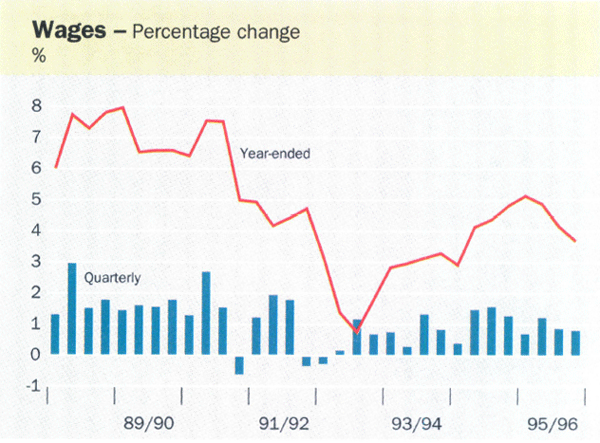
Measures of inflation expectations also suggested that inflationary pressures were being contained. These had deteriorated slightly in 1994, but began to improve through 1995 and into 1996 as economic activity moderated, even though recorded inflation rose. Business surveys showed a consistent picture of declining inflation expectations over 1995/96. The Bank's own survey of market economists, which showed a rise in price expectations for 1995/96 as higher quarterly inflation rates of mid 1995 were incorporated into forecasts, recorded consistent downward revisions as these quarterly readings came to be viewed as temporary.
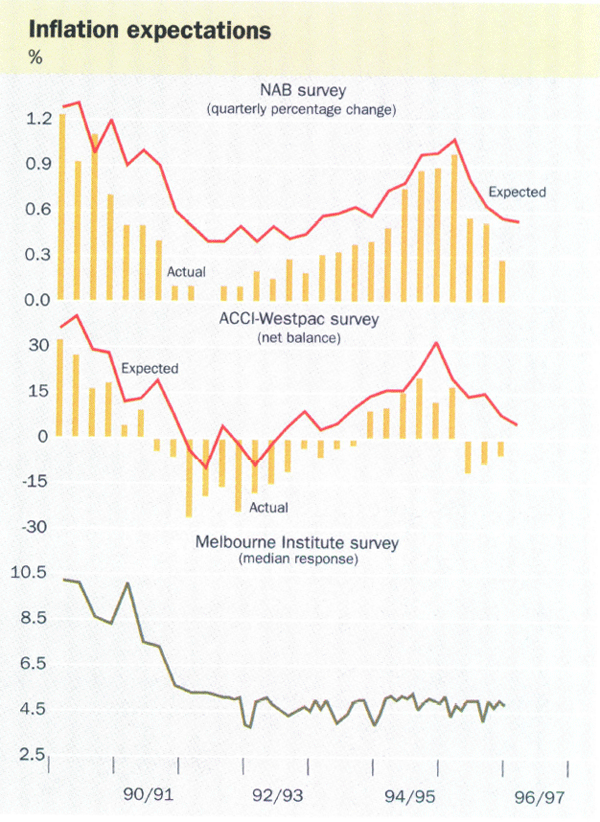
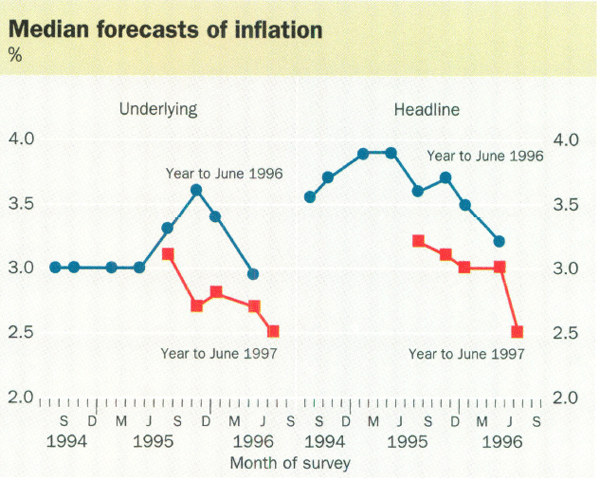
The implicit price deflators from the national accounts, which are more broadly based, but less timely, measures of inflation also moved up late in 1995 and then began to subside. In the year to March, the price deflator for private consumption rose by 2.9 per cent. Reflecting the impact of the stronger exchange rate on prices of imported investment goods, the deflator for domestic final demand rose by 2.3 per cent.
By the June quarter of 1996, both the underlying and headline measures of inflation were running at 3.1 per cent in year-ended terms, and poised to fall further as last year's tax-induced increases fell out of the calculation, and exchange rate effects operated to lower import prices. The moderation in wage costs also had improved prospects that inflation would remain at a rate of 2–3 per cent through 1996/97.
One powerful incentive for Australia to maintain price stability is the more rigorous inflation standards currently being observed in almost all industrial countries. The international norm for inflation is now around 2–3 per cent, with performances in 1995/96 entrenching this more firmly. Inflation has been contained to its lowest rates in a generation in many countries, including in several economies with previously poor or variable inflation records – such as Canada, New Zealand, Finland, Sweden and Spain. The traditional low-inflation countries have also kept inflation low, although in several of these countries it has been accompanied by low economic growth. Although inflation is slightly higher in the United States than in Japan and Germany, the US has demonstrated the feasibility of continuing low inflation with steady growth and low unemployment. In a closely integrated world where reputation is important for capital flows, exchange rates and longer-term interest rates, observing international “best practice” on inflation is worthwhile. So far, Australia has kept up with the pace much better than in the earlier period of global disinflation of the early 1980s, and achieved good rates of growth in the process.
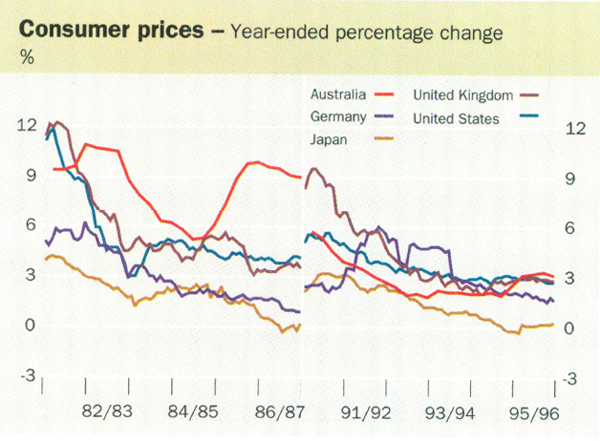
Selected price and cost measures
(Percentage change over year to quarter or month shown)
| June 1992 | June 1993 | June 1994 | June 1995 | Latest, 1996 | |
|---|---|---|---|---|---|
| Consumer prices | |||||
| Consumer price index | 1.2 | 1.9 | 1.7 | 4.5 | 3.1 (Jun) |
| Private consumption deflator # | 2.4 | 2.7 | 1.6 | 3.0 | 2.9 (Mar) |
| Treasury underlying measure | 2.7 | 1.8 | 2.0 | 2.5 | 3.1 (Jun) |
| Producer prices | |||||
| Manufacturing prices* | |||||
| Raw material inputs | 2.3 | 0.7 | 3.3 | 8.2 | −4.9 (May) |
| Intermediate goods | |||||
| – domestic | −0.4 | 1.3 | 1.6 | 5.9 | −0.1 (May) |
| – imported | 1.2 | 8.5 | −3.0 | 12.8 | −4.6 (May) |
| Final products | |||||
| – domestic | 2.0 | 2.6 | 1.2 | 2.6 | 0.2 (May) |
| – imported | 3.5 | 12.8 | −3.2 | 5.6 | −10.8 (May) |
| Building prices | |||||
| House building materials | −0.3 | 4.2 | 3.6 | 2.4 | −1.0 (May) |
| Other building materials | −1.0 | 1.3 | 1.9 | 2.9 | 1.1 (May) |
| Broader measures | |||||
| Domestic final demand deflator # | 1.8 | 2.8 | 1.2 | 2.7 | 2.3 (Mar) |
| Gross Domestic Product deflator # | 1.5 | 1.5 | 1.3 | 2.9 | 2.4 (Mar) |
| Nominal labour costs | |||||
| Average weekly earnings | 4.2 | 2.6 | 2.8 | 3.1 | 2.7 (May) |
| Ordinary-time earnings | 4.7 | 1.8 | 3.3 | 4.8 | 3.7 (May) |
| Private sector ordinary-time earnings | 4.4 | 1.1 | 3.5 | 5.8 | 4.9 (Feb) |
| Unit labour costs** | 1.4 | −0.3 | −0.2 | 5.0 | 2.1 (Mar) |
| Import prices | |||||
| – Import price index | 2.3 | 11.3 | −3.6 | 7.8 | −8.2 (Apr) |
| – Imported consumer items | 0.4 | 3.0 | 2.4 | 1.8 | 0.5 (Jun) |
|
# Fixed-weight index Sources: Australian Bureau of Statistics, Commonwealth Treasury and Reserve Bank |
|||||
Monetary policy
Monetary policy in Australia over the past two years has sought to move the economy on to a more sustainable growth path, thereby containing inflationary pressures. Monetary policy settings were held steady during 1995/96 after the three pre-emptive tightenings between August and December 1994, which saw cash rates increased by 2¾ percentage points to 7.5 per cent. That action had been taken in anticipation that inflation would rise over the period ahead as wage pressures intensified. In the event, the pick-up in inflation was modest and did not warrant additional policy action. As the year progressed, confidence gradually increased that inflation would soon return to the 2–3 per cent range but the evidence was slow to emerge. In those circumstances the Bank was not persuaded that an easing in monetary policy in late 1995 or early 1996 was warranted in Australia.
By mid 1996, the objective of curtailing inflationary pressures had been achieved and, with the fall in unemployment having stalled, the Bank judged that scope existed to adjust policy as insurance against the risk that the economy might falter. Although underlying inflation remained marginally outside the 2–3 per cent range in the June quarter, it was set to come within that objective in the second half of 1996: aggregate wage pressures had abated, the exchange rate was strong and a wide variety of other measures of prices were recording only small increases. With surplus capacity persisting (including in the labour market), any early revival of cost pressures of the kind that had pushed up inflation in 1995/96 seemed unlikely. The reduction in official interest rates in late July to 7.0 per cent was the first since July 1993.
| 17 August 1994 | +¾ |
|---|---|
| 24 October 1994 | +1 |
| 14 December 1994 | +1 |
| 31 July 1996 | −½ |
A full evaluation of policy in the current cycle must await the passage of time, but some tentative conclusions can be drawn. The rise in official interest rates was smaller than in the monetary tightenings of the early and late 1980s and condensed into a shorter period. Policy seems to have had a quick impact on demand without precipitating a sharp dip in output. At the same time, inflation has remained under control.
The effectiveness of monetary policy in the current cycle has been enhanced by the greater transparency of policy, in four aspects:
- adjustments in policy are announced publicly in terms of changes in the cash rate;
- detailed explanations of the policy change are provided at the time;
- the commitment to maintaining medium-term price stability is well articulated and embodied in the inflation objective; and
- the Bank has increased its public presence – through speeches by the Governors and senior staff, and regular articles in the Bank's Bulletin – in order to foster a better understanding of the reasoning behind its actions.
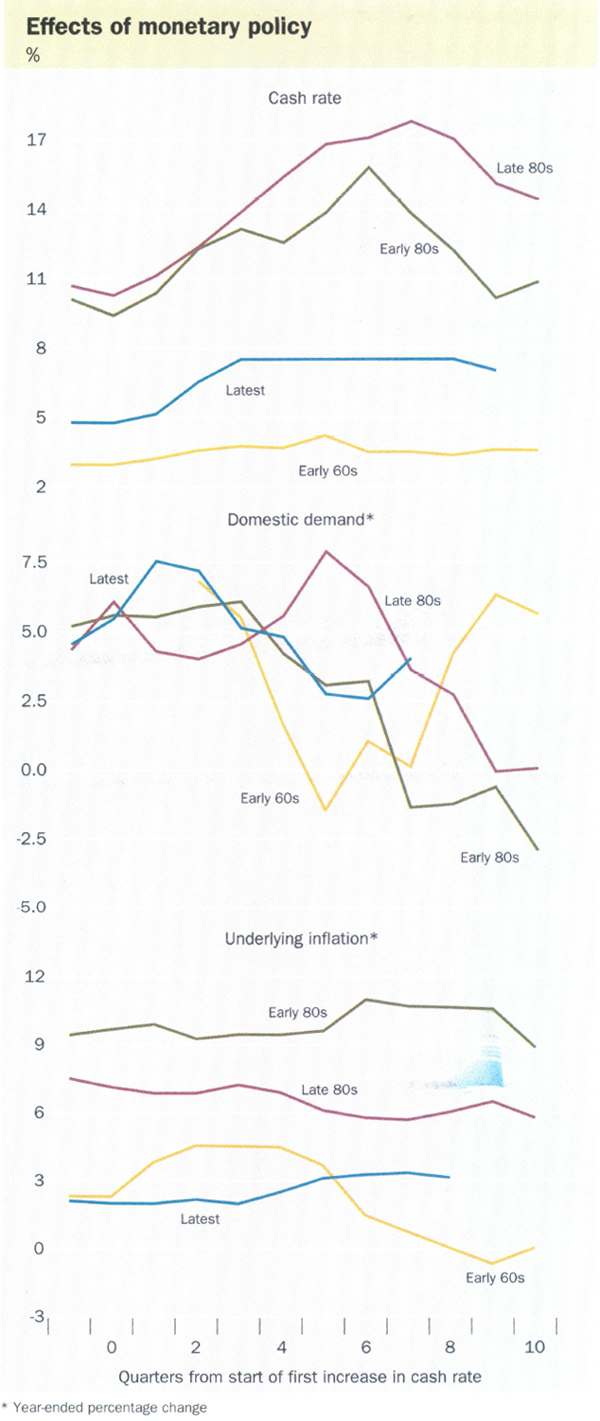
Clearer articulation of policy appears to have added to its effectiveness. In the episode of the late 1980s, an interval of more than 18 months passed between the initial tightening of policy in April 1988 and the slowing of the economy to a sustainable pace of around 3 per cent growth: in the current episode, monetary policy achieved the same effect in six months. It should be acknowledged too, that the conditions of the last few years were not as extreme as the persistent asset-price inflation and deeply rooted inflation expectations of the late 1980s, or the supply-side shocks of the 1970s, which pushed up inflation while depressing demand.
Circumstances and experience were also important. Businesses, consumers and wage-earners had grown accustomed in the 1970s and 1980s to the high interest rates associated with high inflation, and seemed unresponsive to all but large increases in interest rates. With inflation and interest rates lower and much steadier, the “noise” from high inflation was absent in the current episode. This made it easier to adjust interest rates in a timely way to hold the line on inflation, while keeping them low enough to permit continued growth. The freshness of the memory of the recession of the early 1990s, and the high interest rates which accompanied it, might also have encouraged consumers and investors to respond quickly to the moderate increases in intermediaries' rates which followed the policy tightenings. It was helpful, too, that the Government and unions endorsed the Bank's inflation objective.
By making explicit to wage and price-setters what is meant by low inflation, the inflation objective has anchored inflationary expectations. It has also assisted the Bank in making forward-looking decisions: it encouraged timely action in 1994, when inflation remained consistent with the objective, but inflationary pressures were building; and it provided the framework to ease monetary policy in July as confidence grew that inflation was returning to the 2–3 per cent range.
The Bank sees the terms in which the objective is specified – something to be achieved, on average, over the business cycle – as sensible. In particular:
- It has helped balance the twin objectives of price stability and sustained growth by recognising that inflation has a cyclical element, rising as the economy strengthens and falling as slack emerges. To attempt to eliminate or counteract such cyclical movements in inflation could be expected to involve unnecessary fluctuations in output and employment.
- It avoids conveying the impression, as a narrow “hard-edged” target might, that inflation can be controlled within bounds that central banks cannot realistically achieve. Although monetary policy must be set in a forward-looking way, the extent and timing of its effects are difficult to predict with precision. Even occasional failure to achieve a hard-edged inflation target runs the risks of damaging credibility: the Bank's objective aims to achieve what is feasible.
- If unforeseen events do take inflation outside the range, the speed of return should be a matter of careful policy choice, taking into account the output costs involved and the response of price expectations.
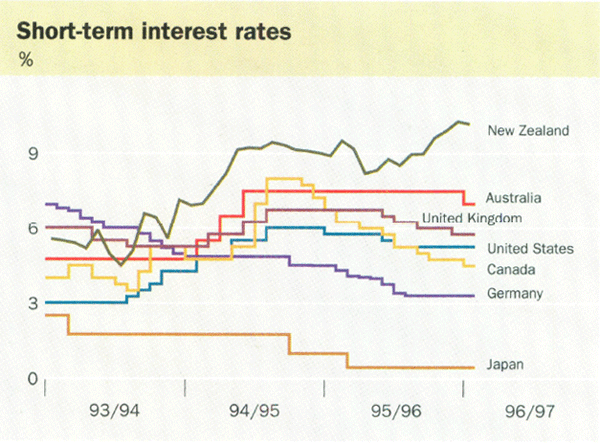
The Australian experience can be compared with contemporaneous US monetary policy, which has faced rather similar cyclical developments. US policy was, as in Australia, “pre-emptive” in tightening before inflation increased but, characteristically, policy moves were smaller and more frequent. It took seven moves to shift US interest rates from 3 per cent in early 1994 to the peak of 6 per cent in early 1995. With demand pressures well contained by 1995, the US authorities were able to lower interest rates without risking a wages outbreak. An important difference between the two countries was the clear containment of wage costs in the US, where wages have shown little upward movement, despite the economy operating at what historically has been full employment.
Looking ahead
The broad forces at work at the beginning of 1996/97 included:
- a reasonably supportive international environment;
- a business community constrained by cost/price pressures but generally positive about the medium term;
- profit levels which, although disappointing compared with expectations, look satisfactory by historical standards;
- an exchange rate which is maintaining competitive pressures on traded good sectors but which is broadly consistent with the “fundamentals” and close to its average level over the past decade;
- prospective fiscal consolidation; and
- a confidence-boosting easing of monetary policy in late July.
These forces should help to underpin the further good growth in business investment that is in prospect. Although aggregate investment has been rising solidly since 1992/93, as a proportion of GDP it remains below its peaks in previous business cycles. The housing cycle is expected to start turning up during 1996/97. Household expenditure has run ahead of income over recent years (partly reflecting adaptation to new borrowing opportunities), and this is not sustainable over the longer term. That said, consumer confidence is reasonably positive, households remain in good shape financially and are therefore in a position to continue to expand spending. On balance, these factors should help to deliver a growth rate sufficient to make modest inroads into the current unacceptably high level of unemployment.
Recent wage outcomes are also a positive sign for the prospects of reducing unemployment. The acceleration of wages growth in 1994/95 might have demonstrated to some that “full employment” had been reached, and that attempts to further reduce unemployment could be expected to put pressure on inflation. That is not a view accepted by the Bank. With hindsight, it appears that the rapid pace of the growth in employment in 1994/95 contributed to the wage acceleration, suggesting that a more gradual reduction in unemployment would be compatible with continuing low inflation.
Further progress on cutting unemployment must remain a high priority. As always, a sustained period of good economic growth would be the most helpful environment in which to make durable progress. This process would be aided by general restraint on costs, to avoid both the kinds of wage-price squeezes which have discouraged employment over the past year, and the uncertainty about monetary policy inevitably associated with strong increases in wages. Wage-setters – on both sides of the negotiating table – should incorporate in their decisions an expectation that inflation will average 2–3 per cent over the years ahead, as it has over the past five years.
The immediate outlook for inflation is favourable. Underlying inflation should shortly be comfortably inside the 2–3 per cent range and should remain there during 1996/97, perhaps drifting up later in the year, as the beneficial effects of the higher exchange rate fade. Business surveys continue to acknowledge the limits to businesses' price-setting power in current circumstances. To the extent that the headline rate of inflation still influences community price expectations, these could be improved if recent mortgage rate cuts result in the headline series dipping below the underlying series.
Continued moderate growth will help to contain aggregate labour costs and contribute to falls in unemployment. High settlements in enterprise bargains remain a source of concern, however, with private sector settlements continuing to edge up. Given the moderation evident in aggregate wages, this suggests that the main burden of wage restraint is being borne by workers on safety-net arrangements and/or those not covered by enterprise agreements.
Perhaps the most hopeful aspect of the inflation outlook is that the community is gradually changing its behaviour as it comes to understand the different incentives provided by a low-inflation world. But there is further to go. The current monetary policy framework is important in this regard: it has helped to preserve a low-inflation environment while keeping the economy on an even keel. The prospects are good for low inflation to continue, and for the economy to grow at a pace consistent with reducing unemployment over time.